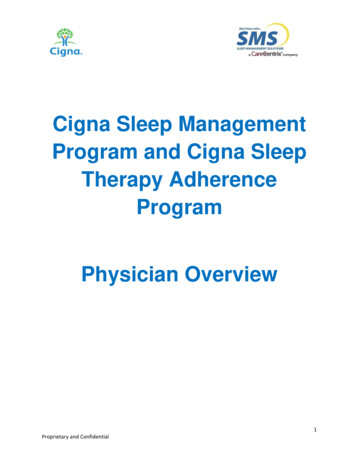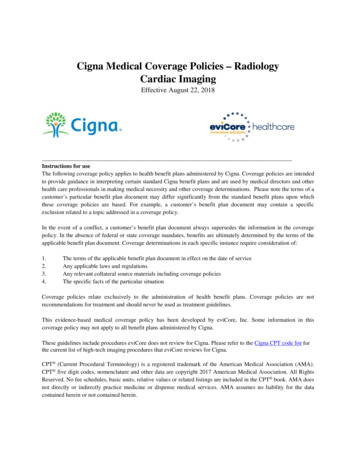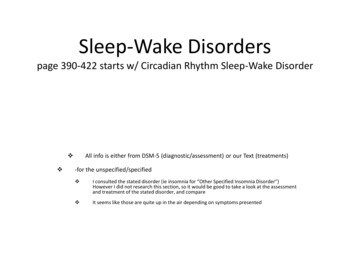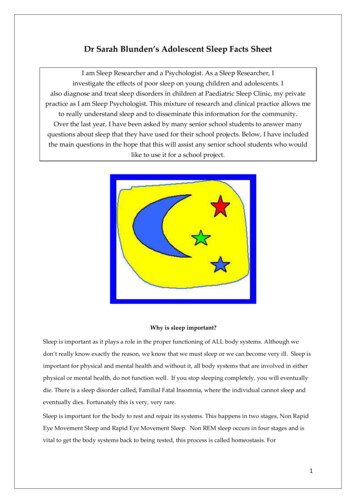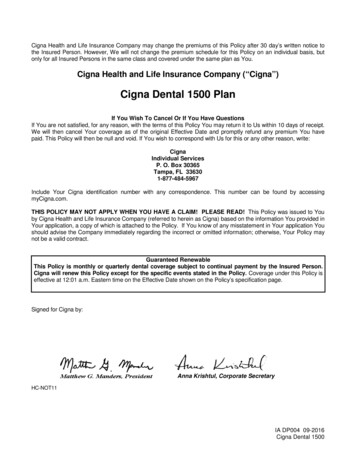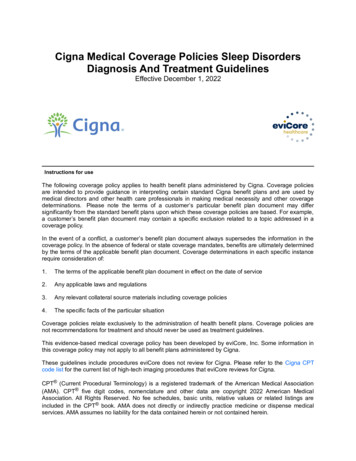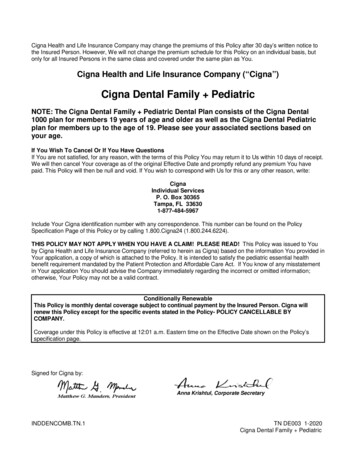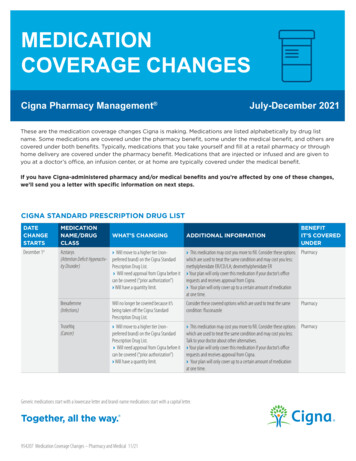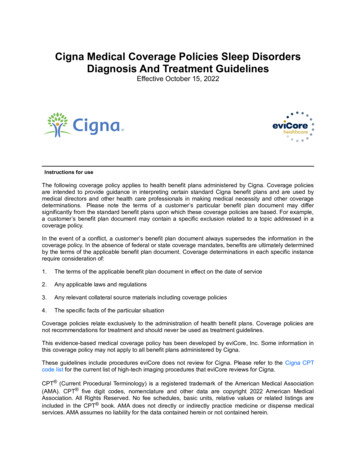
Transcription
Cigna Medical Coverage Policies Sleep DisordersDiagnosis And Treatment GuidelinesEffective October 15, 2022Cigna Medical Coverage PoliciesSleep Disorders Diagnosis and Treatment GuidelinesInstructions for useThe following coverage policy applies to health benefit plans administered by Cigna. Coverage policiesare intended to provide guidance in interpreting certain standard Cigna benefit plans and are used bymedical directors and other health care professionals in making medical necessity and other coveragedeterminations. Please note the terms of a customer’s particular benefit plan document may differsignificantly from the standard benefit plans upon which these coverage policies are based. For example,a customer’s benefit plan document may contain a specific exclusion related to a topic addressed in acoverage policy.In the event of a conflict, a customer’s benefit plan document always supersedes the information in thecoverage policy. In the absence of federal or state coverage mandates, benefits are ultimately determinedby the terms of the applicable benefit plan document. Coverage determinations in each specific instancerequire consideration of:1.The terms of the applicable benefit plan document in effect on the date of service2.Any applicable laws and regulations3.Any relevant collateral source materials including coverage policies4.The specific facts of the particular situationCoverage policies relate exclusively to the administration of health benefit plans. Coverage policies arenot recommendations for treatment and should never be used as treatment guidelines.This evidence-based medical coverage policy has been developed by eviCore, Inc. Some information inthis coverage policy may not apply to all benefit plans administered by Cigna.These guidelines include procedures eviCore does not review for Cigna. Please refer to the Cigna CPTcode list for the current list of high-tech imaging procedures that eviCore reviews for Cigna.CPT (Current Procedural Terminology) is a registered trademark of the American Medical Association(AMA). CPT five digit codes, nomenclature and other data are copyright 2022 American MedicalAssociation. All Rights Reserved. No fee schedules, basic units, relative values or related listings areincluded in the CPT book. AMA does not directly or indirectly practice medicine or dispense medicalservices. AMA assumes no liability for the data contained herein or not contained herein.
Sleep Disorders Diagnosis & Treatment GuidelinesV2.0.2022Table of ContentsGuidelinePageContentsGeneral Information. 3Abbreviations for Sleep Guidelines. 4Preface. 6Sleep Diagnostics. 9Obstructive Sleep Apnea and Other Sleep-related Breathing Disorders (SL-1).10Indications/Diagnostic Testing (SL-2). 18Practice Notes (SL-7). 32Pediatric Sleep Guidelines (SL-3). 34Treatment of Sleep-related Breathing Disorders.38Treatments - General Information. 39Positive Airway Pressure (PAP) Devices (SL-4).43Oral Appliances for the Treatment of Obstructive Sleep Apnea (SL-9).55Sleep Apnea Treatment Program Exclusions (SL-5).58References. 60Pediatric References. 68Questionnaires (SL-8). 70 2022 eviCore healthcare. All Rights Reserved.400 Buckwalter Place Boulevard, Bluffton, SC 29910 (800) 918-89242 of 75www.eviCore.com
General Information3 of 75
Sleep Disorders Diagnosis & Treatment GuidelinesV2.0.2022Abbreviations for Sleep GuidelinesSL.104.Av2.0.2022AbbreviationFull nameAASMAmerican Academy of Sleep MedicineAHIApnea-Hypopnea Index: normal AHI 5 mild OSA: AHI of 5 to 15 moderate OSA: AHI of 15 to 30 severe OSA: AHI of 30AOSATF of AASMAdult Obstructive Sleep Apnea Task Forceof the American Academy of SleepMedicineAPAPAutotitrating positive airway pressureBMIBody mass index (body weight divided bythe square of the height)CPAPContinuous positive airway pressureDOTDepartment of TransportationEDSExcessive daytime sleepinessHCPCSHealthcare Common Procedural CodingSystem (Level II alphanumeric codes used toreport services not included in CPT )HSATHome sleep apnea testingIDTFIndependent Diagnostic Testing FacilitiesJCAHOJoint Commission on Accreditation ofHealthcare OrganizationsMSLTMultiple Sleep Latency TestMWTMaintenance of Wakefulness TestOSAObstructive sleep apneaPMPortable monitoring (in home sleepstudies)PSGPolysomnographyRDIRespiratory disturbance index:(respiratory effort related arousals 2022 eviCore healthcare. All Rights Reserved.400 Buckwalter Place Boulevard, Bluffton, SC 29910 (800) 918-89244 of 75www.eviCore.com
Sleep Disorders Diagnosis & Treatment GuidelinesAbbreviationV2.0.2022Full nameapneas hypopneas/total sleep time) normal RDI 5 mild OSA: RDI of 5 to 15 moderate OSA: RDI of 15 to 30 severe OSA: RDI of 30Epworth Sleepiness Scale, BerlinQuestionnaire (for sleep apnea), STOPBANG questionnaire, Insomnia SeverityIndexOAOral applianceAbbreviationsScreening Tools for Sleep Disorders 2022 eviCore healthcare. All Rights Reserved.400 Buckwalter Place Boulevard, Bluffton, SC 29910 (800) 918-89245 of 75www.eviCore.com
Sleep Disorders Diagnosis & Treatment eline Development (Preface - 1)The cobranded Cigna-eviCore healthcare (eviCore) evidence-based, proprietaryclinical guidelines evaluate a range of advanced imaging and procedures, includingNM, US, CT, MRI, PET, and Radiation Oncology, Sleep Studies and Cardiac and Spineinterventions.Cigna and eviCore reserve the right to change and update the guidelines. Theguidelines undergo a formal review annually. The Cigna-eviCore guidelines are basedupon major national and international association and society guidelines and criteria,peer-reviewed literature, major treatises as well as, input from health plans, practicingacademic and community-based physicians.These Guidelines are not intended to supersede or replace sound medical judgment,but instead, should facilitate the identification of the most appropriate procedure giventhe individual's clinical condition. These guidelines are written to cover medicalconditions as experienced by the majority of individuals. However, these guidelinesmay not be applicable in certain clinical circumstances, and physician judgment canoverride the guidelines.Clinical decisions, including treatment decisions, are the responsibility of the individualand his/her provider. Clinicians are expected to use independent medical judgment,which takes into account the clinical circumstances to determine individualmanagement decisions.Cigna and eviCore support the Choosing Wisely initiative (www.choosingwisely.org) bythe American Board of Internal Medicine (ABIM) Foundation and many nationalphysician organizations, to reduce the overuse of diagnostic tests that are low value,no value, or whose risks are greater than the benefits.The terms "male" and "female" used in these guidelines refer to anatomic-specificdiseases and disease predispositions associated with individuals' sex assigned at birthrather than their gender identity. It should be noted that gender identity and anatomicspecific diseases as well as disease predispositions are not always linked. As such,these guidelines should be applied to the individual's corresponding known orsuspected anatomic-specific disease or disease predisposition. At Cigna and eviCore,we believe that it is important to understand how all individuals, including those whoare gender-diverse, choose to identify themselves. To ensure that gender-diverseindividuals are treated with respect and that decisions impacting their healthcare aremade correctly and with sensitivity, Cigna and eviCore recognize all individuals with thefollowing gender marker options: Male, Female, Transgender male, Transgenderfemale, "X", and "Not specified". 2022 eviCore healthcare. All Rights Reserved.400 Buckwalter Place Boulevard, Bluffton, SC 29910 (800) 918-89246 of 75www.eviCore.com
Sleep Disorders Diagnosis & Treatment GuidelinesV2.0.2022Benefits, Coverage Policies, and Eligibility Issues (Preface - 2)Medical benefits, plan coverage, and eligibility issues pertaining may take precedenceover Cigna-eviCore's cobranded guidelines.Medicare Coverage PoliciesFor Medicare and Medicare Advantage enrollees, the coverage policies of CMS(Centers for Medicare and Medicaid Services) take precedence over Cigna-eviCore'scobranded guidelines.CMS requires coverage for studies requested as part of a CMS approved clinical trialthough the CMS CED program. A list of the currently approved studies is available ith-Evidence-Development/IndexInvestigational and Experimental Studies, Treatments, Procedures, or DevicesCertain studies, treatments, procedures, or devices described in these guidelines areconsidered experimental. Investigational, or unproven. Certain studies, treatments,procedures, or devices may be considered experimental, investigational, or unproven ifthere is a paucity of supporting evidence; if the evidence has not matured to exhibitimproved health parameters; or the study, treatment, procedure, or device lacks acollective opinion of support.Clinical and Research TrialsSimilar to experimental, investigational, or unproven studies, clinical trial requests willbe considered to determine whether they meet coverage.Services inconsistent with established clinical standards or requested for datacollection and not for use in direct clinical management are not supported.Legislative MandateApplicable, state and federal legislation may need to be considered in the review ofprocedure requests.References2. Medicare Coverage with Evidence Development: A Policy-Making Tool in Evolution.Journal of Oncology Practice. 2007;3(6):296-301. doi:10.1200/jop.0763501.3. Coverage of Clinical Trials under the Patient Protection and Affordable Care Act; 42U.S.C.A. § 300gg-8. 2022 eviCore healthcare. All Rights Reserved.400 Buckwalter Place Boulevard, Bluffton, SC 29910 (800) 918-89247 of 75www.eviCore.comPreface1. Prospective Payment Systems - General Information. CMS. ice-Payment/ProspMedicareFeeSvcPmtGen.
Sleep Disorders Diagnosis & Treatment GuidelinesV2.0.2022Overutilization of Testing (Preface-3)A review of the testing history, including all of the following, avoids unnecessary repeattesting: The results of initial studies to narrow the differential diagnosis should be obtainedprior to performing further tests The clinical history should include a potential indication such as a known orsuspected sleep disorder. These potential indications are addressed in greaterdetail within the applicable guidelines. The results of the requested study should be expected to have an impact on patientmanagement or treatment decisions. Criteria for repeat studies are addressed in the applicable guidelineRepeat Sleep Testing -(Home or Attended Sleep Studies)Testing when the same or similar studies have already been conducted is notindicated, without clear rationale that fulfills guideline criteriaPreface 2022 eviCore healthcare. All Rights Reserved.400 Buckwalter Place Boulevard, Bluffton, SC 29910 (800) 918-89248 of 75www.eviCore.com
Sleep Diagnostics9 of 75
Sleep Disorders Diagnosis & Treatment GuidelinesV2.0.2022Obstructive Sleep Apnea and OtherSleep-related Breathing Disorders (SL1)SL.ST.100.Av2.0.2022General Guidelines (SL-1.0)A current and comprehensive clinical evaluation (within 60 days) by the treatingmedical provider, either face to face or telehealth, is required before a sleep study canbe considered. (Note: The rendering site must be a qualified provider of service perhealth plan policy). The clinical evaluation may include a relevant history and physicalexamination, appropriate laboratory studies, and other relevant diagnostic studies(such as a previous sleep study or overnight pulse oximetry). The results of a sleepquestionnaire or sleep questionnaire proxy are required. See: Sleep Questionnaires. Documented history may include the following:o Persistent symptoms present for greater than 4 weeks in duration and notassociated with respiratory infections.o House partners/spouses can describe symptoms, including apneic spells, suchas gasping and choking.o Co-workers, friends, and/or the individual may report that the individual fallsasleep during business meetings, conversations, while stopped at traffic lights,or while driving.o Daytime tiredness and excessive caffeine or stimulant use.o Excessively loud, erratic and variable snoring. (Note: Snoring alone is notalways indicative of OSA).o Frequent awakening during the night.o Increased movements, sleep talking, displaying confused or erratic behaviorduring sleep.o Morning headaches, limited attention, or memory loss.o Drowsy driving or history of car crashes or near miss accidents related tosleepiness.o Prior diagnosis of OSA and response to therapy. Documented physical examination should include:o Cardiopulmonary evaluationo Level of obesity and/or neck circumference 2022 eviCore healthcare. All Rights Reserved.400 Buckwalter Place Boulevard, Bluffton, SC 29910 (800) 918-892410 of 75www.eviCore.com
Sleep Disorders Diagnosis & Treatment GuidelinesV2.0.2022o Oropharyngeal examination including Friedman score or MallampaticlassificationHSAT and/or PSG must be ordered by a treating medical provider andinterpreted by a board-certified sleep medicine physician or a provider that isoverseen by a board-certified sleep medicine physician.NoteDefinitions: Sleep-related Breathing DisordersFor the purpose of this guideline, sleep-related breathing disorders are defined by thefollowing criteria: Valid sleep testing demonstrates a positive diagnosis of one or more of thefollowing sleep-related breathing disorders:Obstructive sleep apnea (OSA) as measured by valid testing is defined as:o The apnea-hypopnea index (AHI), respiratory disturbance index (RDI),respiratory event index (REI) is 15 events per hour; oro The AHI, RDI, or REI is 5 and 15 events per hour and documentation of: Symptoms of sleepiness, nonrestorative sleep, fatigue, or insomnia Report of awakening with breath holding, gasping, or choking Bed partner or other observer reports habitual snoring, breathinginterruptions, or both during sleep Hypertension, a mood disorder, cognitive dysfunction, coronary arterydisease, congestive heart failure, atrial fibrillation, type 2 diabetes mellitus, orstroke.Central sleep apnea (CSA) defined as (all):o Presence of one or more of the following: Sleepiness Difficulty initiating or maintaining sleep, frequent awakenings or nonrestorative sleep Awakening short of breath Snoring Witnessed apneaso Central apnea and/or central hypopnea index 5 per hour 2022 eviCore healthcare. All Rights Reserved.400 Buckwalter Place Boulevard, Bluffton, SC 29910 (800) 918-892411 of 75www.eviCore.comOSA and Other Sleep-related Breathing Disorderso Findings may include macroglossia, tonsillar hypertrophy, nasal polyps, septaldeviation, turbinate hypertrophy, elongated/enlarged uvula, narrow/high archedhard palate retrognathia (recessed mandible) or micrognathia (small mandible).
Sleep Disorders Diagnosis & Treatment GuidelinesV2.0.2022o Central hypopnea/apneas are 50% of the total number of apneas andhypopneaso Presence of one or more of the following: Sleepiness Difficulty initiating or maintaining sleep, frequent awakenings or nonrestorative sleep Awakening short of breath Snoring Witnessed apneas Known atrial fibrillation/flutter, congestive heart failure, or a neurologicaldisordero Central apnea and/or central hypopnea index 5 per houro Central hypopnea/apneas are 50% of the total number of apneas andhypopneaso Pattern of breathing meets criteria for Cheyne-Stokes breathing i.e. periodicbreathing characterized by the waxing and waning of respiratory effort andairflow (episodes of 3 central apneas and/or central hypopneas separated by acrescendo and decrescendo change in breathing amplitude with a cycle lengthof 40 seconds).Treatment Emergent Central Sleep Apnea defined as (both):o Diagnostic PSG demonstrates 5 predominantly obstructive respiratory eventsper hour of sleep (obstructive or mixed apneas, hypopneas, respiratory effortrelated arousals [RERAs]).o PSG during use of positive airway pressure without a backup rate showsimprovement of obstructive events and emergence or persistence of centralapneas/hypopneas with (both): Central apnea and/or hypopnea index 5 per hour Central hypopnea/apneas are 50% of the total number of apneas andhypopneasSleep-related hypoventilation defined as when either of the following occur duringsleep:o Increase in arterial PCO2, transcutaneous PCO2, or end-tidal PCO2 to a value 55 mmHg for 10 minutes 2022 eviCore healthcare. All Rights Reserved.400 Buckwalter Place Boulevard, Bluffton, SC 29910 (800) 918-892412 of 75www.eviCore.comOSA and Other Sleep-related Breathing DisordersCentral sleep apnea (CSA) with Cheyne-Stokes Respiration defined as (all):
Sleep Disorders Diagnosis & Treatment GuidelinesV2.0.2022o There is a 10 mmHg increase in arterial PCO 2, transcutaneous PCO2, or endtidal PCO2 during sleep (compared to awake supine value) to a value 50mmHg for 10 minutesThree sleep questionnaires are commonly used to quantify the level of sleepiness orprobability of having OSA. These validated questionnaires include (but are not belimited to): Epworth Sleepiness Scale Berlin Questionnaire STOP BANG QuestionnaireThe results of these questionnaires help formulate an individual’s likelihood of havingsleep-related disease, so the questionnaires must be appropriate for the specific sleepissue in question (e.g. STOP-BANG and Berlin are most appropriate for OSAevaluation). To view these questionnaires and their interpretation in their entirety, seeQuestionnaires (SL-8).Results of one of these three questionnaires are required, or the following conditioncan serve as a proxy for the sleep questionnaire requirement: Witnessed apnea by a bed partner Previous diagnosis of OSA confirmed in record by prior testing History and physical elements are provided that would permit calculation of theSTOP-BANG survey or Berlin QuestionnaireCoding (SL-1.4)Home Portable Monitoring (PM) (Home Sleep Testing)-Coding (SL-1.4.1)There are currently 3 levels (HCPCS G0398, G0399 and G0400) of home PM’s, withvarying number of monitored parameters. Each can be used with or without anattendant but are generally performed unattended in the patient’s home.Procedure Codes for Home Sleep Testing (HSAT)Home sleep studiesHCPCSHome sleep study testG0398(HSAT) with type II portablemonitor, unattended;minimum of 7 channels:EEG, EOG, EMG,ECG/heart rate, airflow, 2022 eviCore healthcare. All Rights Reserved.400 Buckwalter Place Boulevard, Bluffton, SC 29910 (800) 918-8924ChannelsAt least 7 monitoredchannels.13 of 75www.eviCore.comOSA and Other Sleep-related Breathing DisordersSleep Questionnaires
Sleep Disorders Diagnosis & Treatment GuidelinesHome sleep studiesV2.0.2022HCPCSChannelsHome sleep test (HSAT)with type III portablemonitor, unattended;minimum of 4 channels: 2respiratorymovement/airflow, 1ECG/heart rate, and 1oxygen saturationG0399At least 4 monitoredchannels(airflow/ventilation, heartrate, oxygen saturation,respiratory movement)Home sleep test (HSAT)with type IV portablemonitor, unattended;minimum of 3 channelsG0400Measures 1 to 3parametersPSG Procedure Codes for Unattended Sleep StudiesUnattended sleep studiesCPT Sleep study, unattended, measures a95800minimum of heart rate, oxygen saturation,and respiratory analysis (e.g., by airflow orperipheral arterial tone), and sleep time. Simultaneous recording; heart rate,oxygen saturation, and respiratoryanalysis (e.g., by airflow or peripheralarterial tone), and sleep time. For unattended sleep study thatmeasures a minimum of heart rate,oxygen saturation, and respiratoryanalysis, report CPT 95801Sleep study, unattended, measures a95801minimum of heart rate, oxygen saturation,and respiratory analysis (e.g., by airflow orperipheral arterial tone) Simultaneous recording; minimum ofheart rate, oxygen saturation, andrespiratory analysis (e.g., by airflow orperipheral arterial tone). For unattended sleep study thatmeasures a minimum of heart rate,oxygen saturation, and sleep time, 2022 eviCore healthcare. All Rights Reserved.400 Buckwalter Place Boulevard, Bluffton, SC 29910 (800) 918-892414 of 75www.eviCore.comOSA and Other Sleep-related Breathing Disordersrespiratory effort andoxygen saturation
Sleep Disorders Diagnosis & Treatment GuidelinesUnattended sleep studiesV2.0.2022CPT Sleep study, unattended, simultaneous95806recording of heart rate, oxygen saturation,respiratory airflow and respiratory effort(e.g., thoracoabdominal movement) Simultaneous recording; minimum ofventilation, respiratory effort, ECG orheart rate, and oxygen saturation. Do not report CPT 95806 inconjunction with any of the followingcodes: CPT 93041-93229, 9326893272, or 95800-95801Polysomnography (facility-based-PSG) - Coding (SL-1.4.2)PSG Procedure Codes for Attended Polysomnography and Sleep StudiesAttended polysomnography and sleepstudiesCPT Multiple sleep latency or maintenance of 95805wakefulness testing, recording, analysisand interpretation of physiologicalmeasurements of sleep during multipletrials to assess sleepiness or ability toremain awake. Multiple sleep latency testing (MSLT) isperformed prior to treatment when therequesting physician suspectsnarcolepsy. MSLT must be requested with a facilitysleep study performed the night beforethe CPT 95805 (CPT 95810 or CPT 95811). See Maintenance of Wakefulness Testing (MWT)(SL-2.3) - See Maintenance of Wakefulness Testing(MWT)-Indications and Criteria (SL-2.4)Polysomnography; (any age), sleepstaging with 1-3 additional parameters ofsleep, attended by a technologist95808Sleep study, simultaneous recording of95807 2022 eviCore healthcare. All Rights Reserved.400 Buckwalter Place Boulevard, Bluffton, SC 29910 (800) 918-892415 of 75www.eviCore.comOSA and Other Sleep-related Breathing Disordersreport CPT 95800
Sleep Disorders Diagnosis & Treatment GuidelinesAttended polysomnography and sleepstudiesV2.0.2022CPT OSA and Other Sleep-related Breathing Disordersventilation, respiratory effort, ECG or heartrate, and oxygen saturation, attended by atechnologist with PAP titration May be considered experimental,investigational, or unproven when95807 or 95807-52 is utilized torequest a PAP-NAP.Polysomnography; (age 6 years or older), 95810sleep staging with 4 or more additionalparameters of sleep, attended by atechnologist. CPT 95810 is used to report full-nightdiagnostic studies.Polysomnography; (age 6 years or older), 95811sleep staging with 4 or more additionalparameters of sleep, with initiation ofcontinuous positive airway pressuretherapy or Bi-level ventilation, attended bya technologist CPT 95811 is used either as either asplit-night study with both thediagnostic study and the subsequentpositive airway pressure or bi-levelventilation are initiated during thesame visit, or as PAP titration aloneafter CPT 95810 or inability tocomplete split night sequence or as aretitration of PAP therapy.The following are pediatric codes.Attended Polysomnography and Sleep Studies (Pediatric Codes)Attended polysomnography and sleepstudiesCPTPolysomnography, (younger than 6 years), 95782sleep staging with 4 or more additionalparameters of sleep, attended by atechnologist.Polysomnography, (younger than 6 years), 95783sleep staging with 4 or more additional 2022 eviCore healthcare. All Rights Reserved.400 Buckwalter Place Boulevard, Bluffton, SC 29910 (800) 918-892416 of 75www.eviCore.com
Sleep Disorders Diagnosis & Treatment GuidelinesAttended polysomnography and sleepstudiesV2.0.2022CPT 2022 eviCore healthcare. All Rights Reserved.400 Buckwalter Place Boulevard, Bluffton, SC 29910 (800) 918-8924OSA and Other Sleep-related Breathing Disordersparameters of sleep, with initiation ofcontinuous positive airway pressuretherapy or bi-level ventilation, attended bya technologist.17 of 75www.eviCore.com
Sleep Disorders Diagnosis & Treatment GuidelinesV2.0.2022Indications/Diagnostic Testing (SL-2)SL.ST.101.Av2.0.2022Home Sleep Apnea Testing (HSAT) Indications (SL-2.1) HSAT can be performed when both of the following criteria are met:o Increased risk of moderate-to-severe OSA as determined by one of thefollowing: Reported symptoms of excessive daytime sleepiness and at least two of thefollowing three criteria (habitual loud snoring, witnessed apnea or gasping orchoking, or diagnosed hypertension) Validated questionnaire (STOP BANG or Berlin). SeeQuestionnaires (SL-8).o HSAT can physically be performed and individual has the mobility, dexterity andcognitive ability to use the available equipment safely at home and the ability tofollow instructions. Individuals who exhibit one of the co-morbid indications for attended sleep studiesfound in In-Laboratory Polysomnography - OSA Indications (SL-2.2) can undergo facility testing asoutlined in Laboratory Polysomnography - OSA Indications or home sleep apneatesting (HSAT) if preferred by the treating provider. HSAT can also be used in follow-up treatment results after any of the following:o Surgical treatment for moderate to severe OSA.o OSA Oral appliance trial.o Other non-PAP supportive interventions (e.g. positional therapy).In-laboratory Polysomnography- OSA Indications (SL-2.2)PSG (CPT 95810 or 95811) can be considered when sleep survey or proxysymptom(s) lead to concern for OSA and one of the following: Facility testing can be considered rather than HSAT due to one of the followingreasons:o OSA symptoms with low pretest probability of moderate-to-severe OSA definedby either of the following: Lack of reported symptoms of excessive daytime sleepiness and at leasttwo of the following three criteria (habitual loud snoring, witnessed apnea orgasping or choking, or diagnosed hypertension). 2022 eviCore healthcare. All Rights Reserved.400 Buckwalter Place Boulevard, Bluffton, SC 29910 (800) 918-892418 of 75www.eviCore.com
Sleep Disorders Diagnosis & Treatment Guidelines V2.0.2022Validated questionnaire (STOP BANG or Berlin) indicating low risk. SeeQuestionnaires (SL-8).o Individual does not have the mobility, dexterity or cognitive ability to use homesleep apnea testing equipment safely at home and the ability to followinstructions.o HSAT has been attempted and is negative, or technically inadequate (reportsubmitted for review). Technically inadequate HSAT recordings lack a minimumof 4 hours of oximetry and flow data. At least one of the following suspected or known co-morbid diagnoses isdocumented:Obesity and one of the following:o Obesity hypoventilation syndrome defined as BMI 30 kg/m2 plus awake arterialblood gas, end-tidal PCO2 (ET PCO2), or transcutaneous PCO2 with PCO2 45OR venous blood gas showing a PCO2 50 mmHgo If ABG, ET PCO2 or transcutaneous PCO2 results are not available, serumbicarbonate 27 may be provided as an alternative to determine high risk forOHSModerate to severe pulmonary disease (for example: COPD, asthma) asdemonstrated by one or more of the following:o Nocturnal oxygen useo Documented arterial blood gases showing PO2 60 or PCO2 45o Documented pulmonary function tests demonstrating moderate to severeobstruction with forced expiratory volume in one second (FEV1) 69% ofpredictedDocumented neurological diseaseAny of the following:o The neurological disease precludes the individual’s ability to perform homesleep apnea testing due to physical limitation (e.g. documented stroke withresidual weakness/lack of coordination that would prevent performance of homesleep apnea testing) ORo There is stated concern for central sleep apnea or hypoventilation (e.g.neuromuscular disease such as myotonic dystrophy or ALS) 2022 eviCore healthcare. All Rights Reserved.400 Buckwalter Place Boulevard, Bluffton, SC 29910 (800) 918-892419 of 75www.eviCore.comIndications and Diagnostic Testingo BMI 45
Sleep Disorders Diagnosis & Treatment GuidelinesV2.0.2022Moderate to severe congestive heart failureWith documented pulmonary congestion or known left ventricular ejection fraction 45%Pulmonary HTNWith documentation of a mean pulmonary artery pressure of 25 mm Hg
The cobranded Cigna-eviCore healthcare (eviCore) evidence-based, proprietary clinical guidelines evaluate a range of advanced imaging and procedures, including NM, US, CT, MRI, PET, and Radiation Oncology, Sleep Studies and Cardiac and Spine interventions. Cigna and eviCore reserve the right to change and update the guidelines. The
